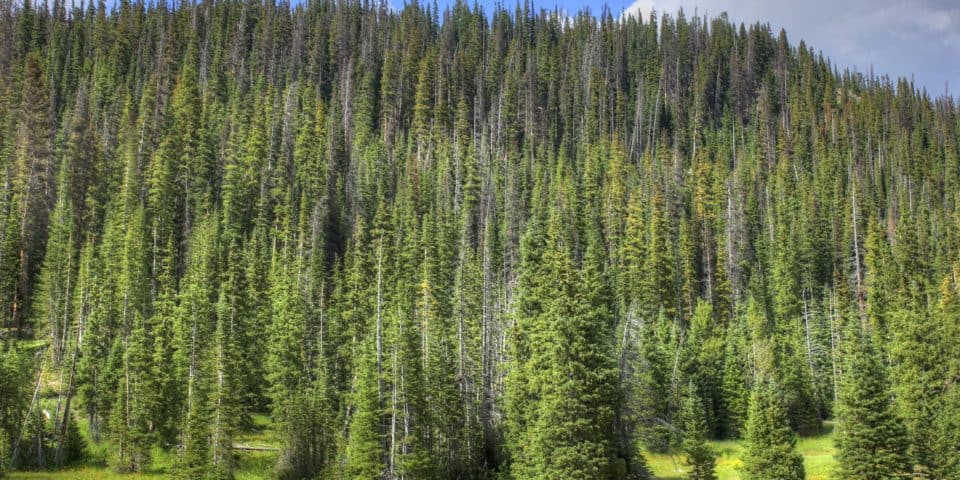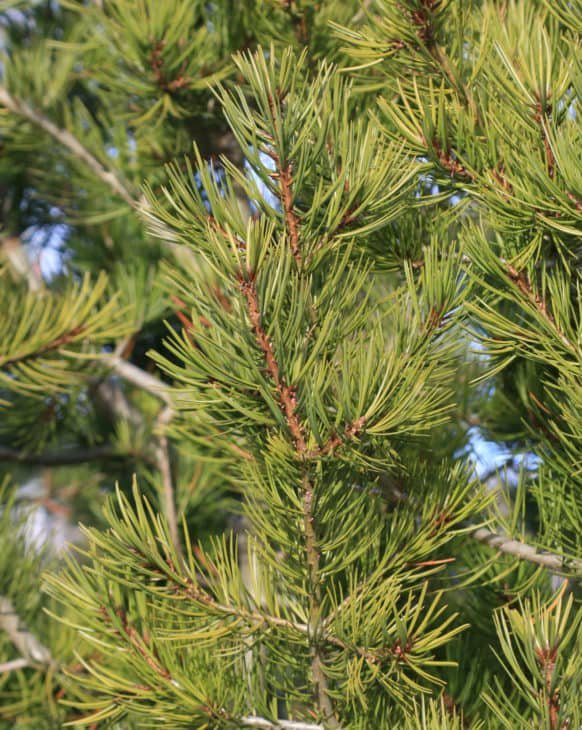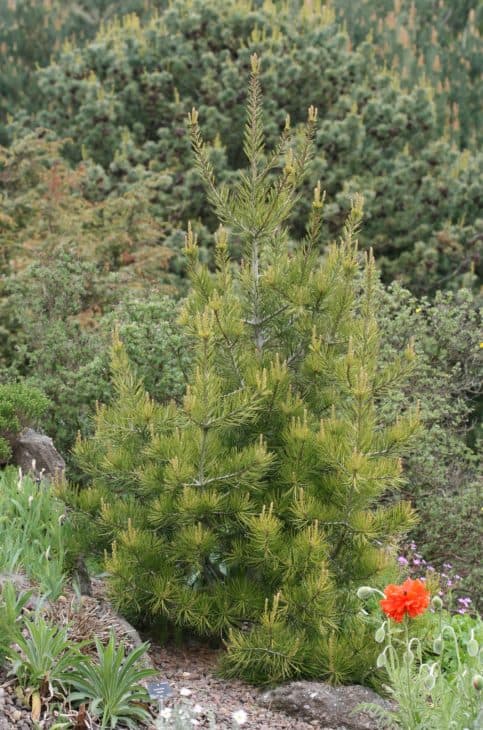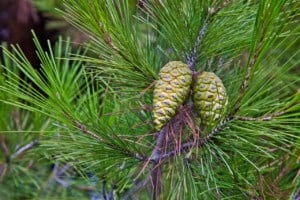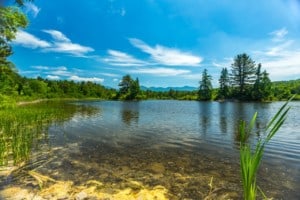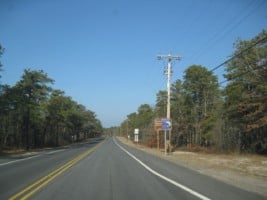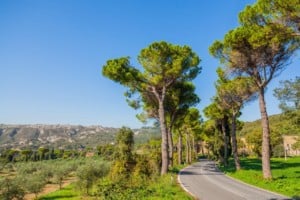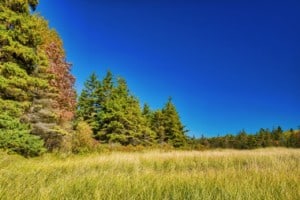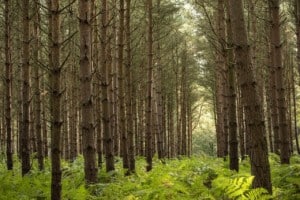Wherever you go in North America, it is difficult not to see pine trees. These are tall, elegant trees that have a multitude of purposes; in fact, more pine is used to make lumber than any other type of wood, making the pine tree a significant contribution to our society.
Contents
- 1. Aleppo Pine (pinus halepensis)
- 2. Swiss Mountain Pine (pinus mugo)
- 3. Bishop Pine (pinus muricata)
- 4. Black Pine (pinus nigra)
- 5. Bristlecone Pine (pinus longaeva)
- 6. Bunya Pine (araucaria bidwillii)
- 7. Caribbean Pine (pinus caribaea)
- 8. Cook Pine (araucaria columnaris)
- 9. Coulter Pine (pinus coulteri)
- 10. Gray Pine (pinus sabiniana)
- 11. Himalayan White Pine (pinus wallichiana)
- 12. Jack Pine (pinus banksiana)
- 13. Japanese Black Pine (pinus thunbergii)
- 14. Japanese Red Pine (pinus densiflora)
- 15. Japanese White Pine (pinus parviflora)
- 16. Jeffrey Pine (pinus jeffreyi)
- 17. Knobcone Pine (pinus attenuata)
- 18. Lacebark Pine (pinus bungeana)
- 19. Limber Pine (pinus flexilis)
- 20. Loblolly Pine (pinus taeda)
- 21. Lodgepole Pine (pinus contorta)
- 22. Longleaf Pine (pinus palustris Mill.)
- 23. Maritime Pine (pinus pinaster)
- 24. Mason Pine (pinus massoniana)
- 25. Mexican Pine (pinus ayacahuite)
- 26. Parry Pine (pinus quadrifolia)
- 27. Pitch Loblolly Pine (pinus rigida x taeda)
- 28. Pitch Pine (pinus rigida)
- 29. Pond Pine (pinus serotina)
- 30. Ponderosa Pine (pinus ponderosa)
- 31. Queensland Pine (Araucaria cunninghamii)
- 32. Radiata Pine (pinus radiata)
- 33. Red Pine (pinus resinosa)
- 34. Sand Pine (pinus clausa)
- 35. Santa Cruz Island Pine (pinus Muricata remorata)
- 36. Scots Pine (pinus sylvestris)
- 37. Shortleaf Pine (pinus echinata)
- 38. Singleleaf Pinyon Pine (pinus monophylla)
- 39. Slash Pine (pinus elliottii)
- 40. Southern Foxtail Pine (pinus balfouriana austrina)
- 41. Spruce Pine (pinus glabra)
- 42. Stone Pine (pinus pinea)
- 43. Sugar Pine (pinus lambertiana)
- 44. Table Mountain Pine (pinus pungens)
- 45. Torrey Pine (pinus torreyana)
- 46. Two Needle Pinon Pine (pinus edulis)
- 47. Virginia Pine (pinus virginiana)
- 48. Washoe Pine (pinus washoensis)
- 49. Western White Pine (pinus monticola)
- 50. White Pine (pinus strobus)
- 51. Whitebark Pine (pinus albicaulis)
To begin with, pine trees are coniferous trees that live anywhere from 100 to 1000 years and the majority of them get to roughly 150 feet. Some, however, have been known to get as high as 260 feet but that isn’t the norm. Pine trees have four different types of leaves even though the needle type is the one that most people are familiar with.
Of course, the most significant feature of the pine tree is its cones and most pines have both male and female cones on the same tree. When the cones are mature, they usually open up so that the seeds can be released.
There are roughly 125 species of pine trees, not counting subspecies and the 35 unresolved species. Nearly all of them can be found in the United States and they are described below.
1. Aleppo Pine (pinus halepensis)
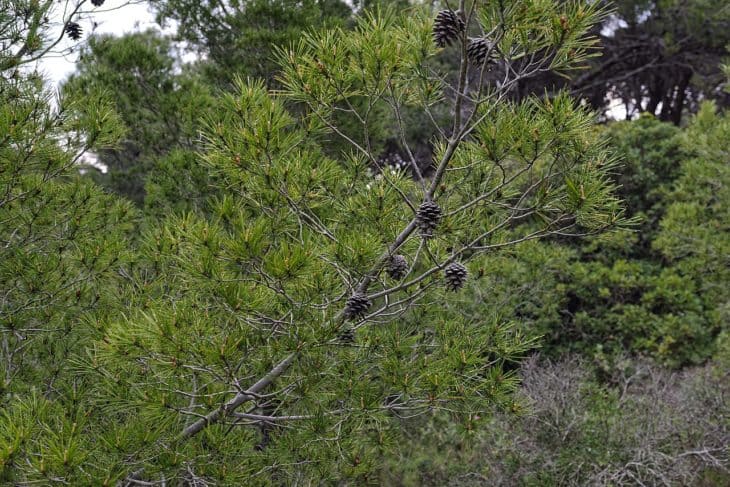
This pine tree usually grows in low elevations and they get from 50 to 80 feet high, making them a small to medium-sized pine tree. The needles are slender and yellowish-green in color and they grow in groups of two. Even the cones are somewhere slender at 4.5” x 1.25”.
2. Swiss Mountain Pine (pinus mugo)
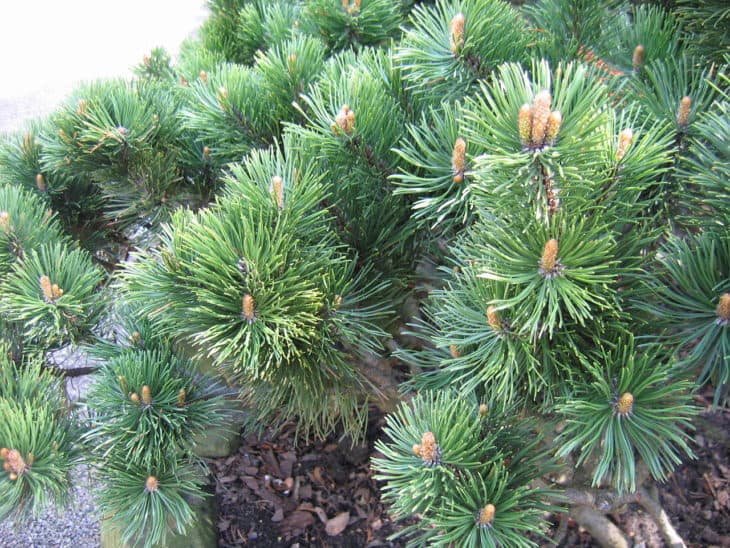
The Swiss Mountain pine has needles that are bright green in color and grow in pairs. The cones are nut-brown and more than two inches long. There are three subspecies of this tree, with one being a hybrid. The buds and cones are sometimes used to make pine syrup.
3. Bishop Pine (pinus muricata)
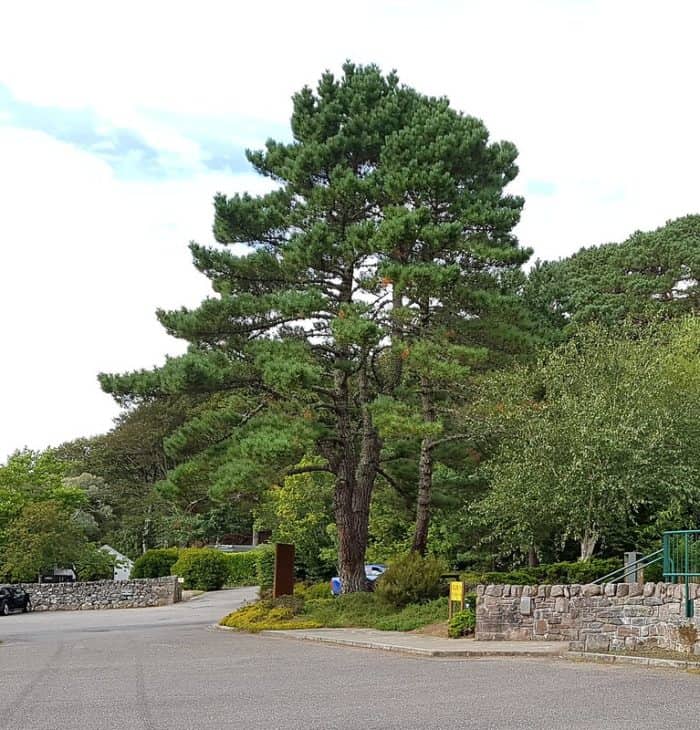
Grown mostly in California and Mexico and always grown near a coast, the Bishop pine can get to roughly 80 feet high. It has green or blue-green needles that grow to 6.5 inches long. Pine trees are often used in plantations and are frequently found in public places, including gardens and parks, because they are easy to grow and gorgeous to boot.
4. Black Pine (pinus nigra)
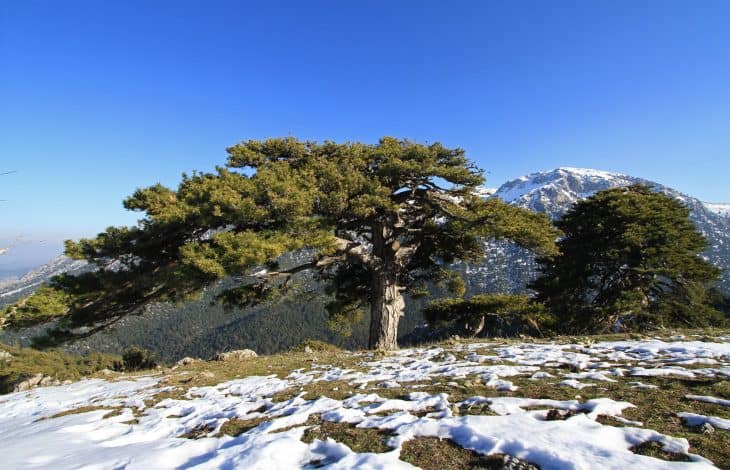
Also called the Austrian pine, the black pine tree can grow in different elevations, up to 5200 feet above sea level or higher. Usually ranging from 70 to 115 feet high, the black pine can get up to 20 to 40 feet in diameter, making it a stately looking tree indeed. It is commonly used as lumber but has other uses as well.
5. Bristlecone Pine (pinus longaeva)
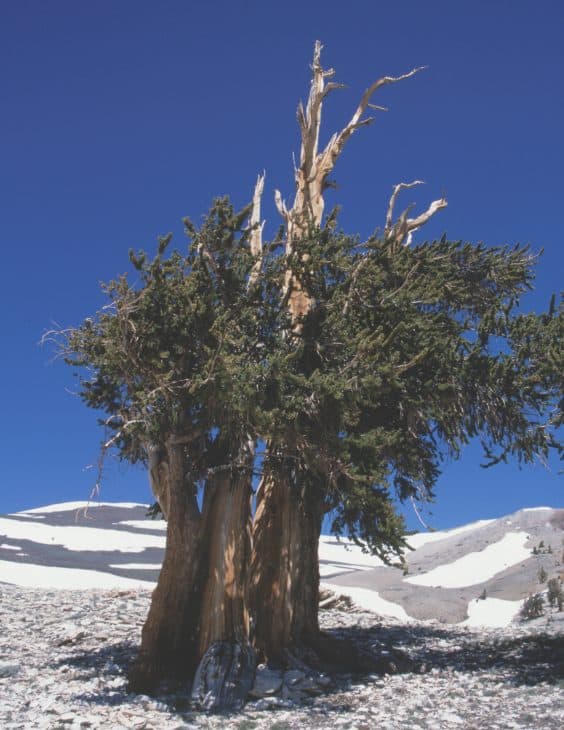
Also called the Great Basin pine, this tree is considered a medium-sized tree because it only reaches 15 to 50 feet in height. Its needles grow in groups of five and are deep green to blue-green on the outside. Interestingly, the leaves of the tree can remain on the tree for up to 45 years.
6. Bunya Pine (araucaria bidwillii)
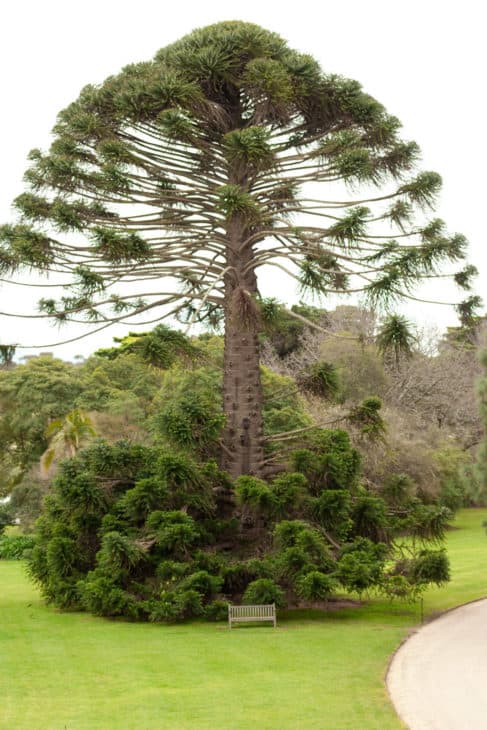
The bunya pine can grow up to 140 feet in height and have extra-large cones that are the size of footballs. It is found throughout most parts of Australia; in fact, the tallest bunya pine is found in Queensland, Australia and boasts a height of 169 feet. Its nuts are eaten by both wildlife and humans. They have even been boiled down to make a nutritious tea.
7. Caribbean Pine (pinus caribaea)
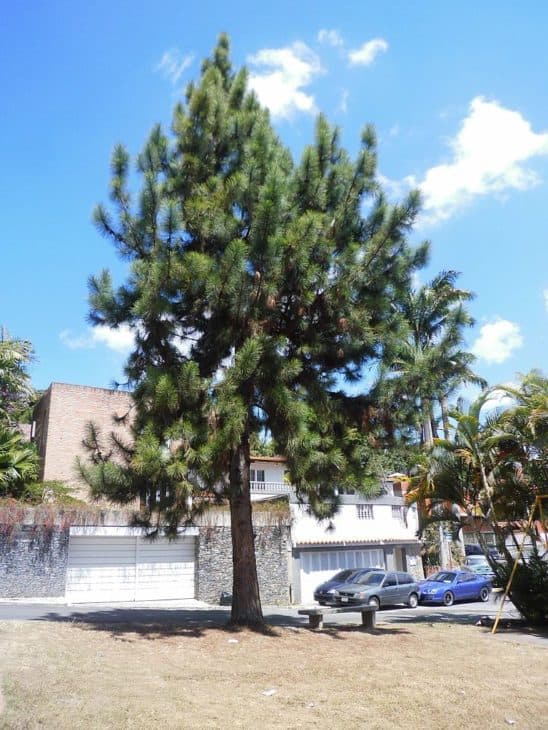
The Caribbean pine is a very hard pine and is known to have three varieties. Its wood is used as lumber and pulpwood. Most of it is shipped to Florida. It is commonly found in tropical and subtropical coniferous forests such as the Bahamian pineyards and others. You can also find them in areas such as Jamaica, Colombia, Sri Lanka, and China as well as the United States.
8. Cook Pine (araucaria columnaris)
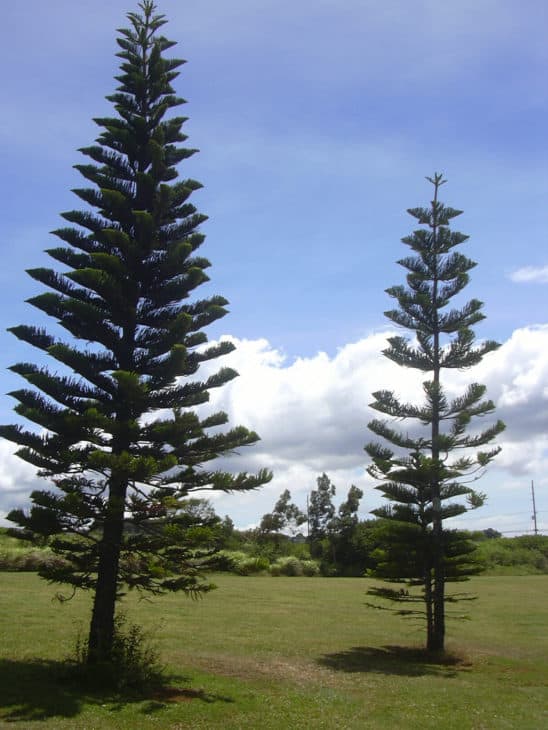
Also called the coral reef pine, the cook pine is a narrow tree that usually gets up to around 200 feet when it’s in its native habitat. The tree’s gray resinous bark is paper thin and tears off like sheets of paper. It is often found in public gardens and landscapes, especially in warmer climates.
9. Coulter Pine (pinus coulteri)
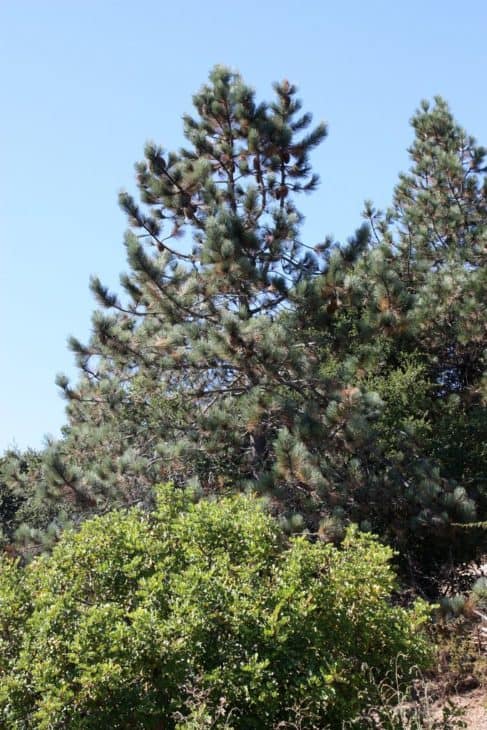
The Coulter pine tree grows from 33 to 79 feet and has a trunk that can be as wide as 3.3 feet. The tree has very large, spiny cones that get up to 15 inches long and they can weigh up to 11 pounds. Since the wood of the tree is rarely soft, its limited use includes making firewood. The large seeds inside the cones provide nourishment for wildlife.
10. Gray Pine (pinus sabiniana)
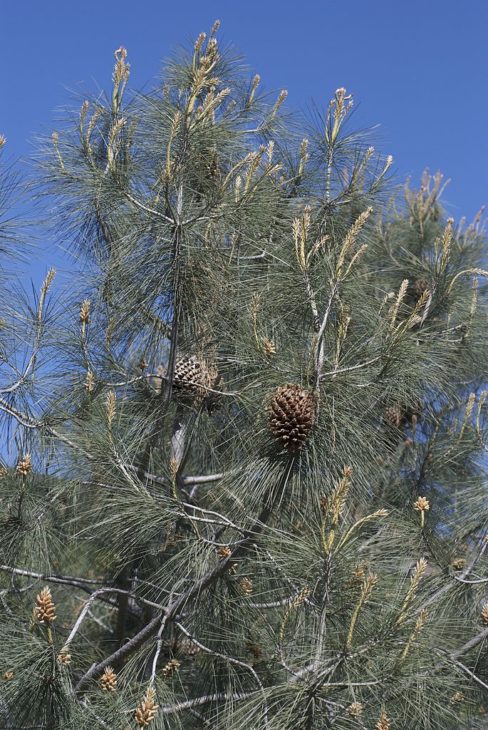
Also known as the foothill or digger pine, the gray pine doesn’t get very large; in fact, it usually grows to no more than 45 feet in height. Its cones, however, are large and heavy and can get to nearly 14 inches in length. Caterpillars and moths eat the seeds inside the cones and some Native American groups still eat the sweet pine nuts as a snack.
11. Himalayan White Pine (pinus wallichiana)
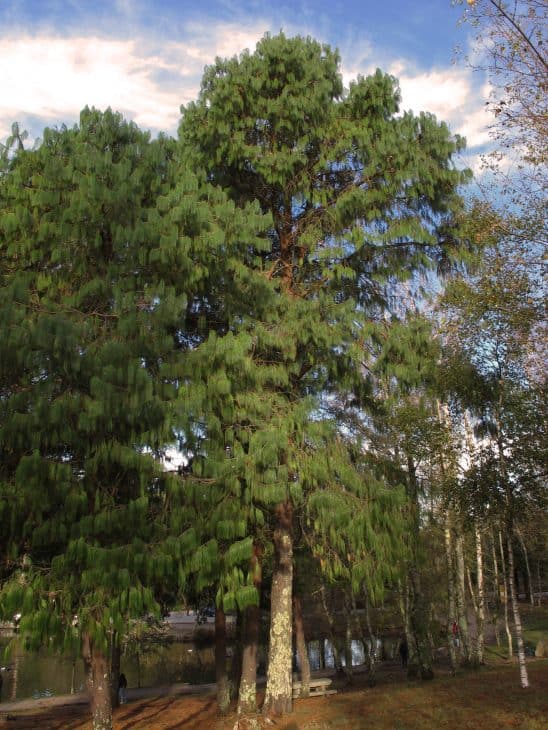
The Himalayan white pine reaches 98 to 164 feet in height and is also called the blue or Bhutan pine. The wood is a moderately hard wood and is used mostly for firewood. It has a very resinous pungent odor. This tree is a very popular choice in parks and public landscapes because of its large cones that are long, slender, and yellow to buff in color.
12. Jack Pine (pinus banksiana)
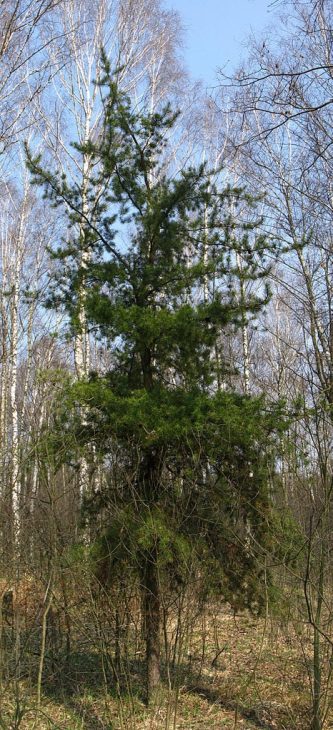
Native to Canada east of the Rocky Mountains, the jack pine is also called the scrub or gray pine and grows from 30 to 72 feet high. The leaves grow in bundles of two and are roughly 1.5 inches long. The pine cones are curved at the tip and get to two inches in length. The wood tends to be used for items such as pulpwood, decking, and utility poles.
13. Japanese Black Pine (pinus thunbergii)
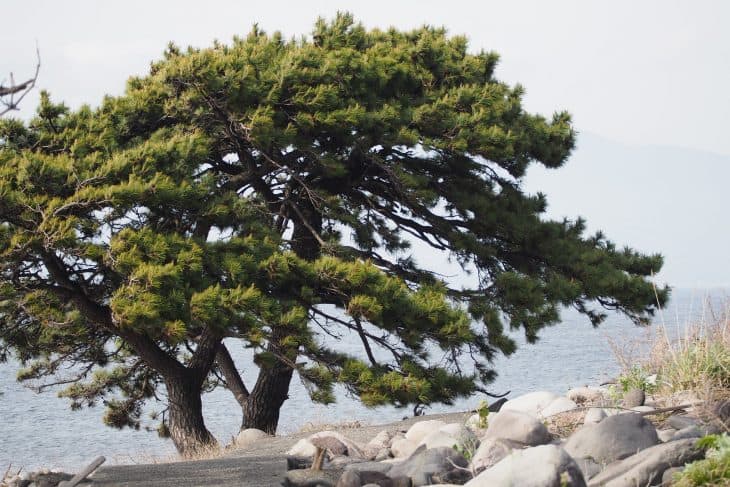
Japanese black pines get to no more than around 130 feet high and they are frequently used as a horticultural tree. The tree is often trained from a young age to be decorative and elegant-looking, making it a great bonsai tree for many. The bark starts out gray but turns to black as the tree matures. It becomes quite thick on older trees.
14. Japanese Red Pine (pinus densiflora)
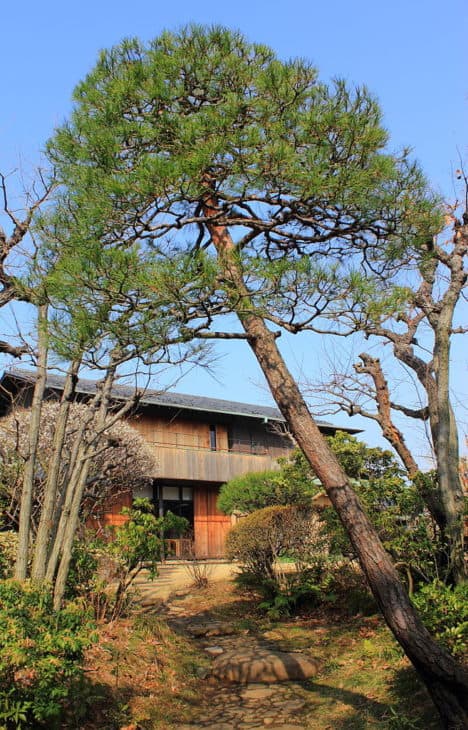
Also called the Korean red pine, this tree has cones that grow to nearly four inches in length and has a special status in Korea. It grows best when the sun is out and when the soil is slightly acidic. The needles grow in groups of two. The Japanese red pine looks similar to the Scots pine but has leaves that are long and slender.
15. Japanese White Pine (pinus parviflora)
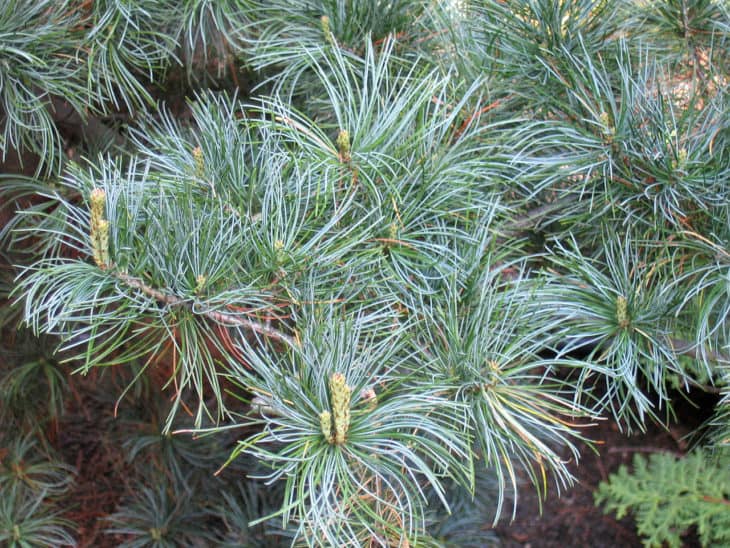
Also known as the five-needle pine, this tree grows to roughly 80 feet high and the cones are roughly 2.75 inches long with broad, rounded scales. The seeds are roughly half an inch long and the tree itself is popular as a decorative tree. Not only does it make a good bonsai tree but you can often find it planted in popular public spots throughout most cities.
16. Jeffrey Pine (pinus jeffreyi)
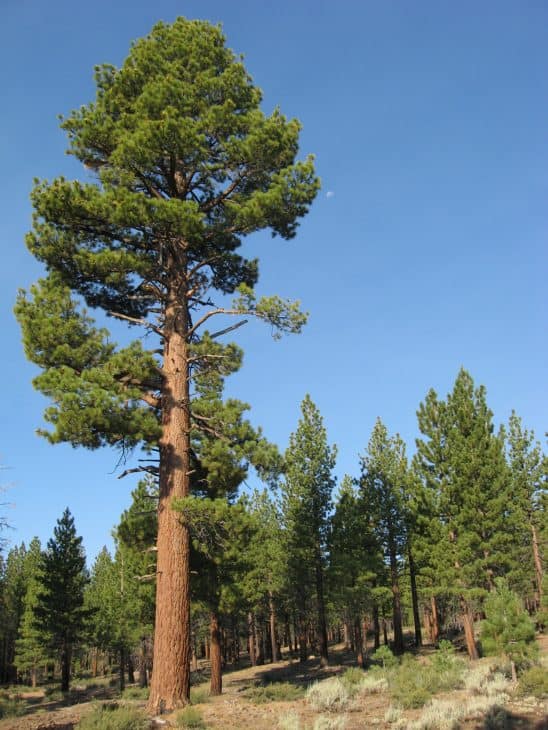
The Jeffrey pine is also known as a yellow pine and reaches 80 to 130 feet in height. Some, however, have gotten to over 170 feet high. The cone has sharp barbs on it. One of the most significant aspects of this tree is its aroma, which can resemble vanilla, violets, pineapple, apple, or even butterscotch. It also has a lot in common with the Ponderosa pine.
17. Knobcone Pine (pinus attenuata)
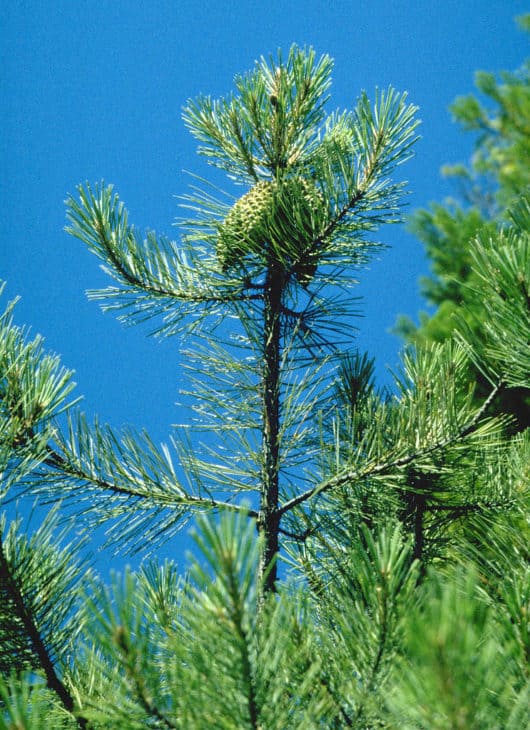
This pine tree has a very straight, erect trunk and it usually gets from 25 to 80 feet in height. With smooth flaky bark and leaves that grow in groups of three, the knobcone pine tree has cones that will remain closed for many years at a time, usually only opening to release the seeds when a fire occurs.
18. Lacebark Pine (pinus bungeana)
The lacebark pine tree is slow-growing when compared to other types of pines. It is used in a lot of Asian countries as a decorative tree. In fact, the tree is often found in botanical gardens and other places open to the public and its bark offers something unique — peeling plates of several different colors. It is also a sign of longevity in some cultures.
19. Limber Pine (pinus flexilis)
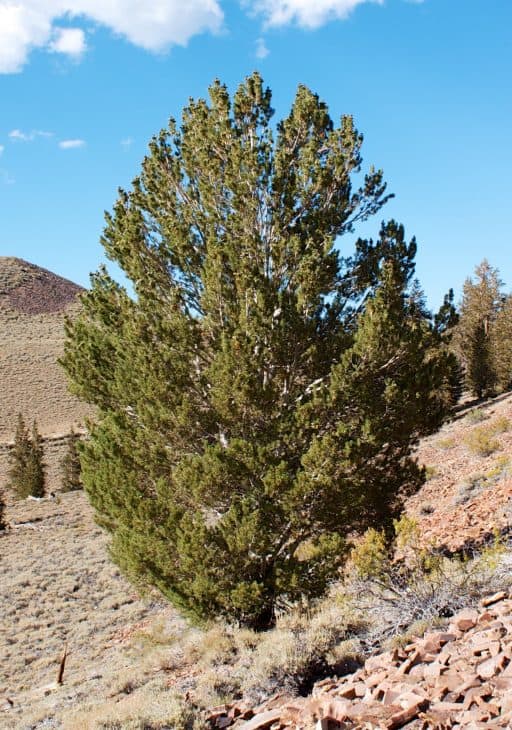
The limber pine tree can grow for very long periods of time. In fact, one of these trees in Eagle Cap Wilderness, Oregon, has been found to be more than 2000 years old. Its average height is around 65 feet but some have been known to grow to 80 feet in height. The main use for this tree is its nuts, which are eaten by both wildlife and some humans.
20. Loblolly Pine (pinus taeda)
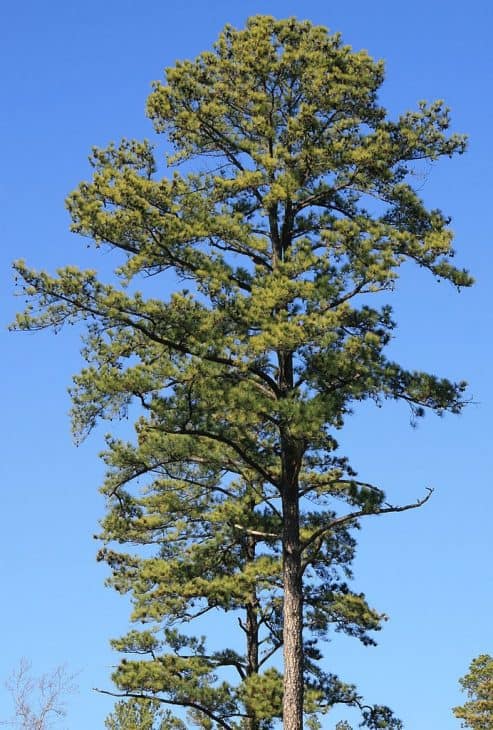
Native to the southeastern United States, the loblolly pine tree is found mostly in swamps and lowland areas. It grows to around 100 feet and has a trunk of nearly five feet in diameter. The cones get up to five inches in length and some of the seeds found their way on the Apollo 14 mission.
21. Lodgepole Pine (pinus contorta)
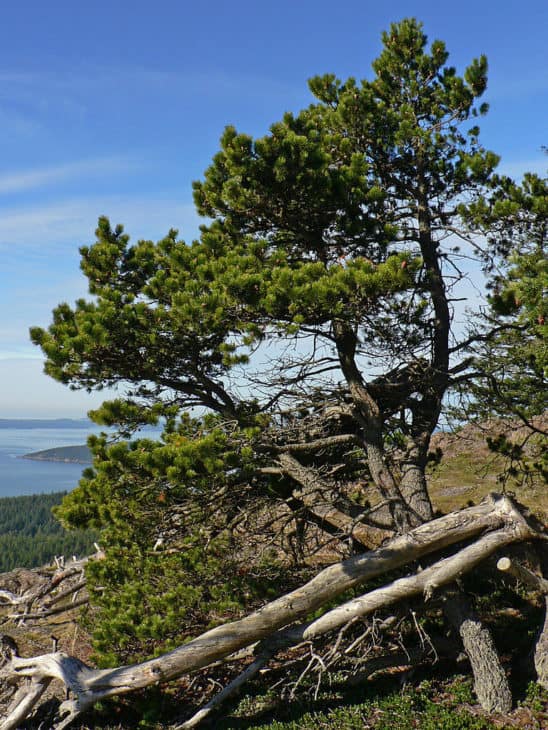
Also called the shore or Tamarack pine tree, the lodgepole is very commonly found near oceans and in dry montane forests, rarely in lowlands. There are four different subspecies of the tree and it typically grows from 130 to 160 feet high. It often has a twisted, bent shape and its prickly cones are only one to three inches long.
22. Longleaf Pine (pinus palustris Mill.)
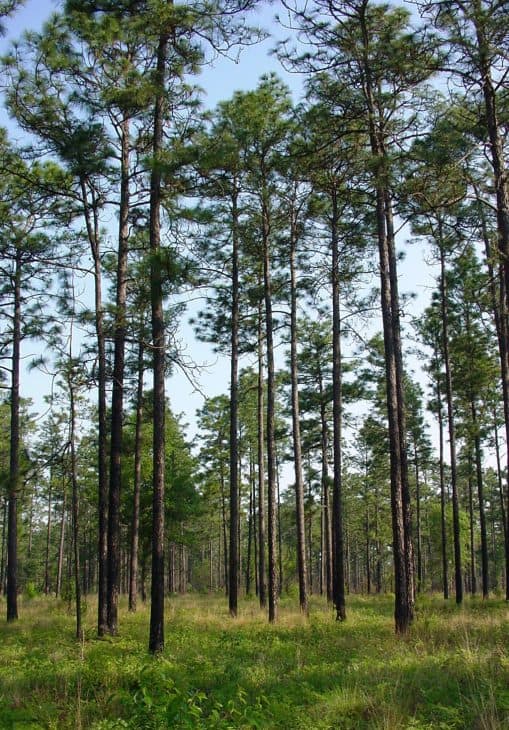
The longleaf pine tree gets to roughly 115 feet high and has a trunk that is roughly 28 inches in diameter. This tree is a cultural symbol in the southern part of the country and is the state tree of Alabama. Its wood is yellow, resinous, and used mostly for lumber and pulp.
23. Maritime Pine (pinus pinaster)
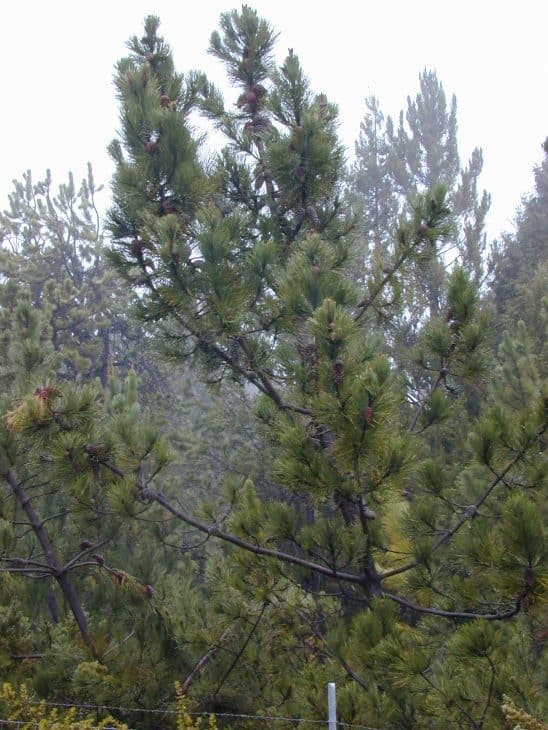
Also called the Mediterranean pine, the maritime pine is usually found in low to medium altitudes and typically gets to 110 feet high. The cones are long and slender. It is commonly used as an ornamental or decorative tree as well as being a source of dietary supplements derived from the bark.
24. Mason Pine (pinus massoniana)
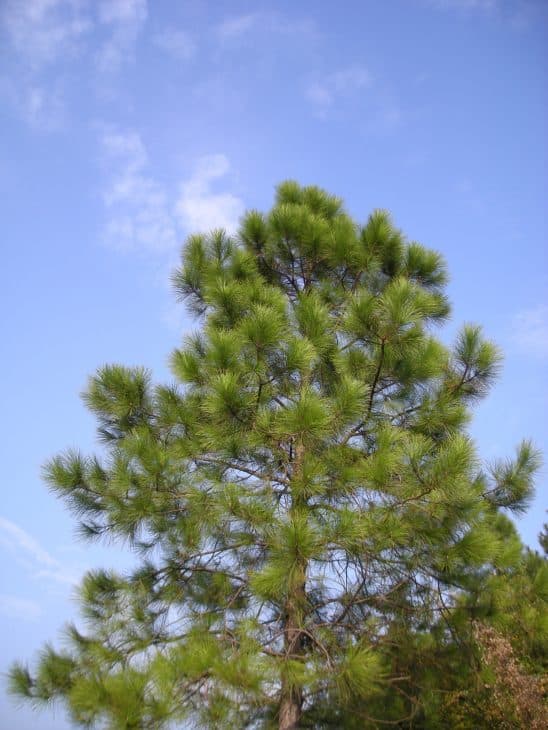
Mason pine trees grow from 80 to around 150 feet high and have cones that mature in 18 to 20 months. It is used commonly for plantation forestry and the logs are used mostly as pulp in the paper industry. The bark itself is often used in parts of Asia as a medicinal tea.
25. Mexican Pine (pinus ayacahuite)
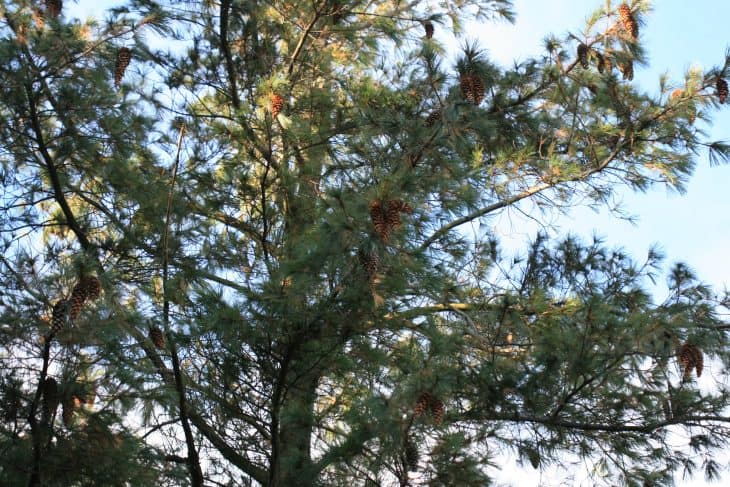
The Mexican pine is a large tree that gets up to nearly 150 feet high. It is used frequently in the paper industry and as an ornamental tree in a lot of public places. It is also called the Mexican white pine and both its cones and seeds are long and slender.
26. Parry Pine (pinus quadrifolia)
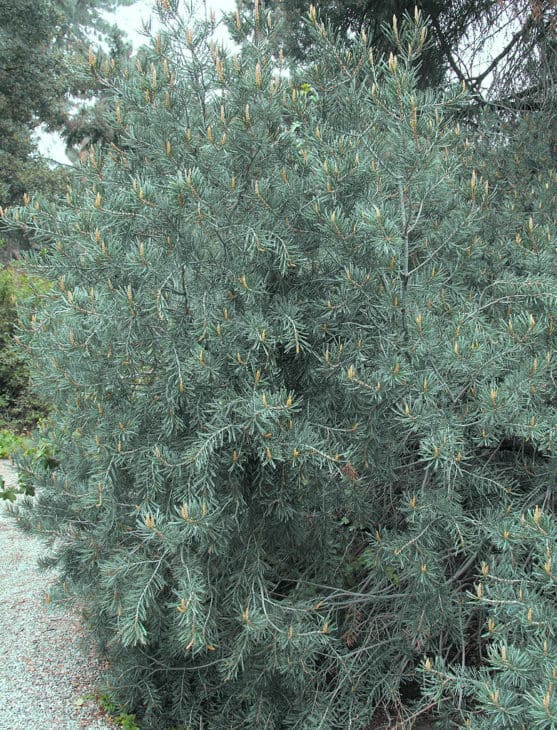
Native to southern California and parts of Mexico, the parry pine tree is considered a medium-sized tree because it rarely gets past 50 feet high. Occasionally used as a Christmas tree, it has been used extensively in the past for firewood, incense, roofs, and basketry.
27. Pitch Loblolly Pine (pinus rigida x taeda)
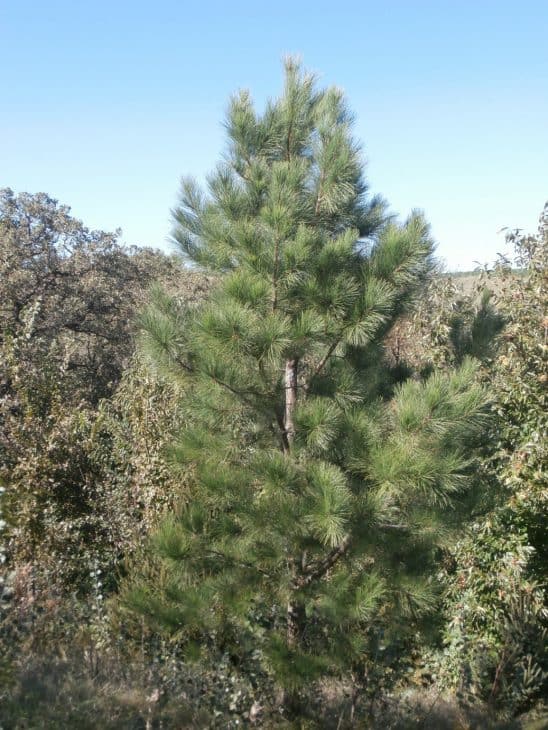
Also called the Pitlolly Pine, this is a hybrid tree that grows up to 90 feet high and 40 feet in diameter. It has gray, scaly bark and dark green foliage. In the past, it has been used extensively as hedges or screens and even in conservation planting. It is a very hardy and easy-to-grow pine tree that attracts various birds.
28. Pitch Pine (pinus rigida)
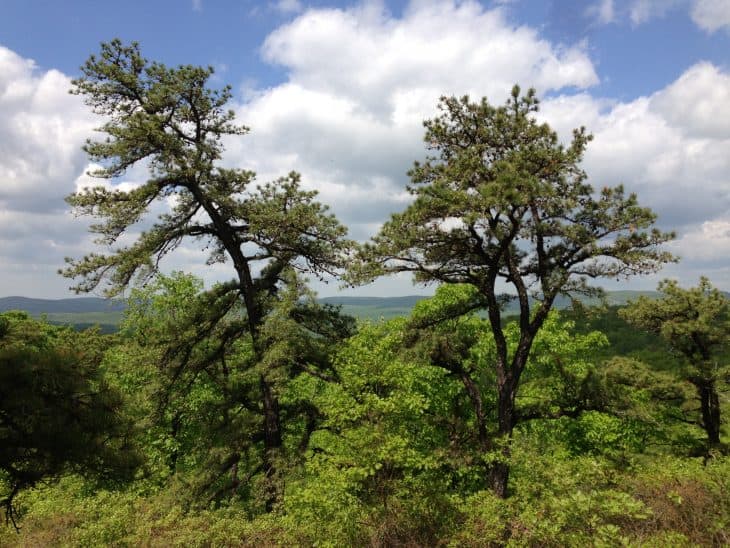
The pitch pine gets anywhere from 20 to roughly 100 feet high and has branches that are often twisted, meaning that self-pruning is impossible. The trunks can have a curve to them at times and it is also a fast-growing tree. Because of its twisted trunks and branches, it doesn’t have much commercial use.
29. Pond Pine (pinus serotina)
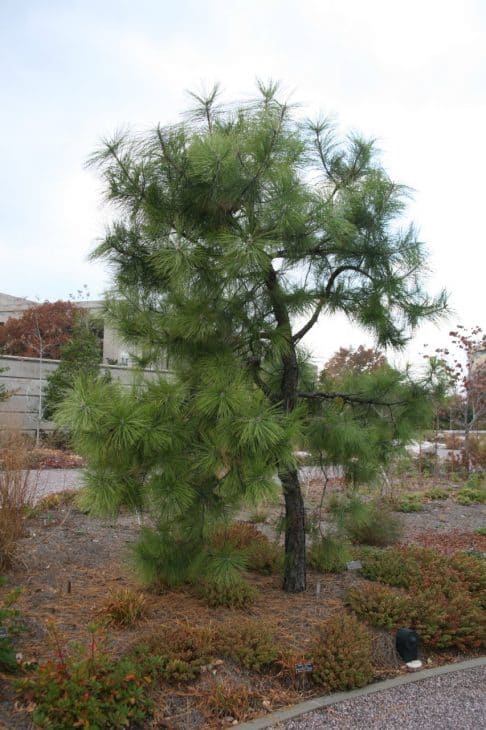
Also called a marsh pine, the pond pine can grow up to 69 feet high but often has a twisted shape to it. The cones are almost completely round in shape and the tree is usually found in wet areas such as ponds and swamps. The cones usually remain closed for long periods of time.
30. Ponderosa Pine (pinus ponderosa)
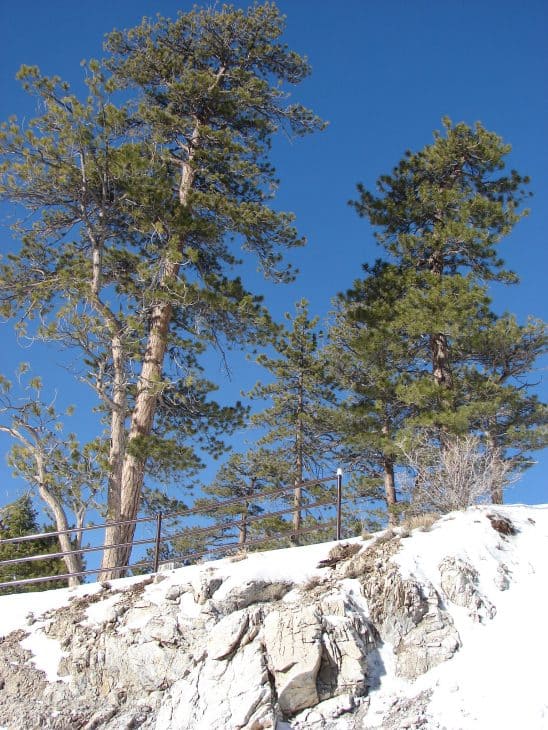
Also called the bull or blackjack pine, this pine tree is a very large tree that can get up to 235 feet in height. In fact, in 2011 a ponderosa pine was recorded at a little over 268 feet. In the mid-1950s, the trees were used in nuclear testing at a Nevada test site.
31. Queensland Pine (Araucaria cunninghamii)
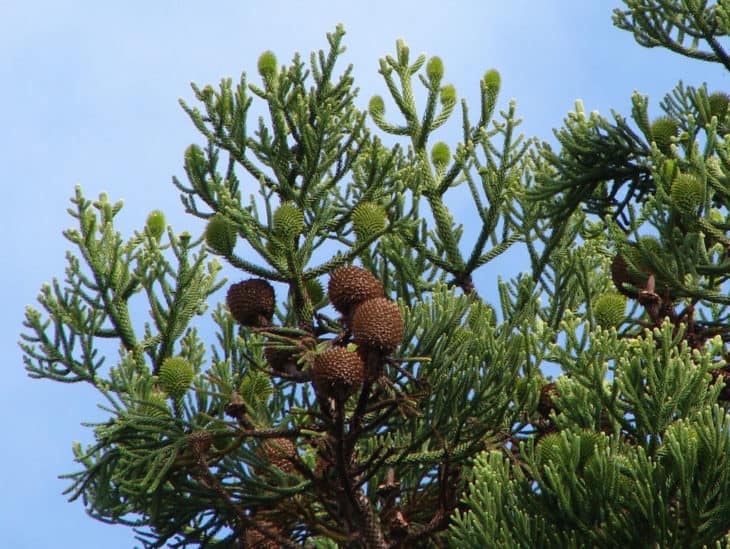
The Queensland pine tree is also called the hoop pine and has wood that is especially high in quality. Therefore, it is used for furniture, paneling, joinery, veneer, flooring, and even boats. Aborigines in Australia even used the resin as cement so it is a very versatile tree indeed.
32. Radiata Pine (pinus radiata)
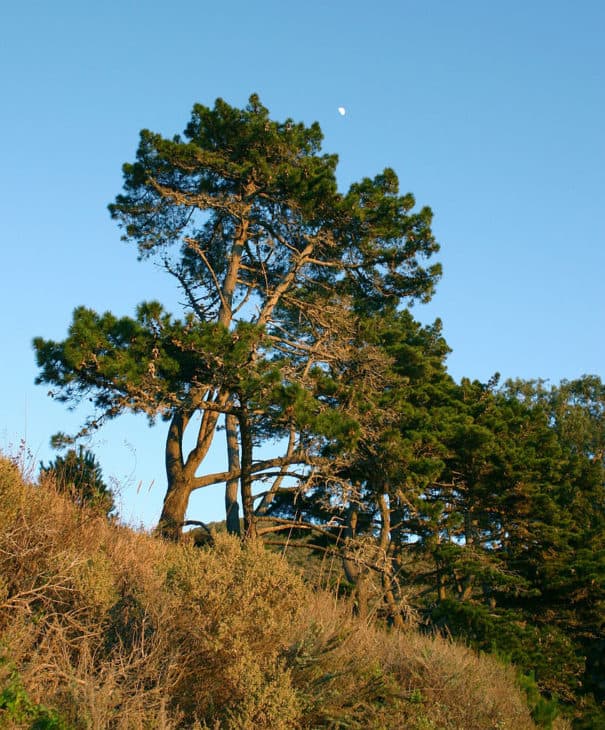
Also called the Monterey pine, this tree gets up to 100 feet high naturally but as high as 200 feet when it’s cultivated. The needles grow in bundles of three and the wood is used extensively as plywood, weatherboards, fencing, retaining walls, and posts and beams, being very important in the construction industry.
33. Red Pine (pinus resinosa)
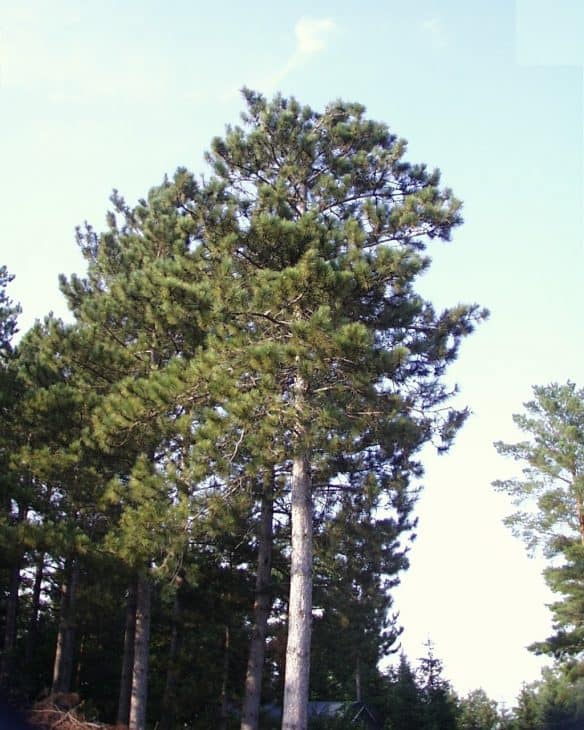
Also called Norway pine, the red pine tree grows from 65 to 115 feet in height and has a trunk that is three feet in diameter. It has thick bark and grows tall and straight in numerous habitats. It also has symmetrical ovoid cones that are almost stalkless and have no prickles.
34. Sand Pine (pinus clausa)
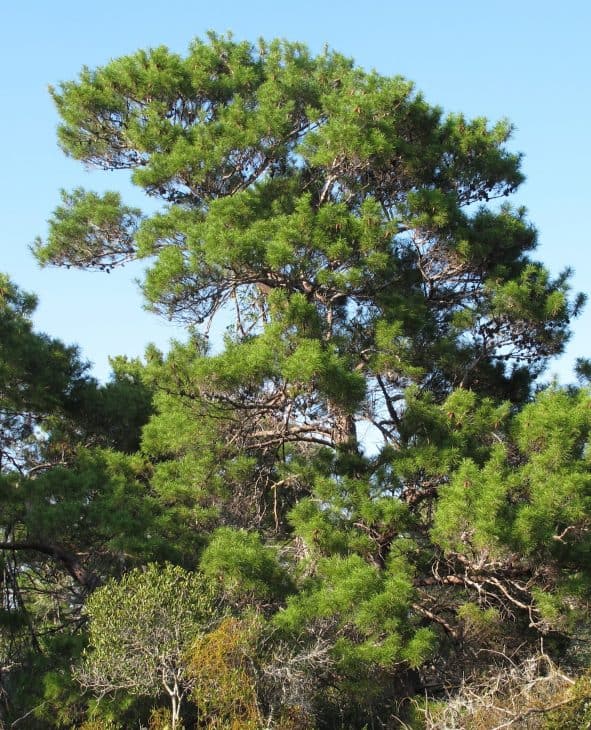
The sand pine is found mostly in well-drained, infertile, sandy habitats, hence the name. It is a small tree that only grows to around 30 feet high and its needles grow in groups of two. It is easy to care for but has limited commercial use and is mostly used for wood pulp.
35. Santa Cruz Island Pine (pinus Muricata remorata)

Also called the bishop pine, this tree usually gets to around 80 feet in height and has two forms: one with bright green needles and one with dark blue-green needles. You can find this tree in a lot of parks and outdoor areas because of its beauty and ease of growing.
36. Scots Pine (pinus sylvestris)
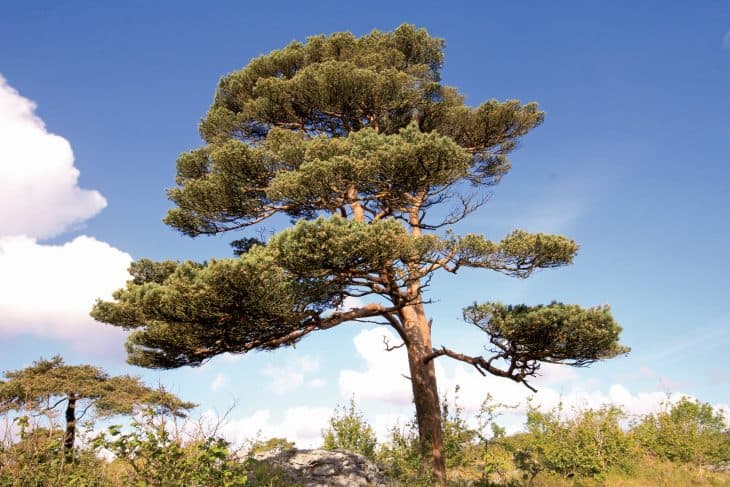
Oddly, the Scots pine grows best in less-than-perfect conditions including poor and sandy soil, peat bogs, and rocky outcrops. It can get up to 115 feet in height and the cones change colors throughout their growing season. There are four subspecies of this pine tree.
37. Shortleaf Pine (pinus echinata)
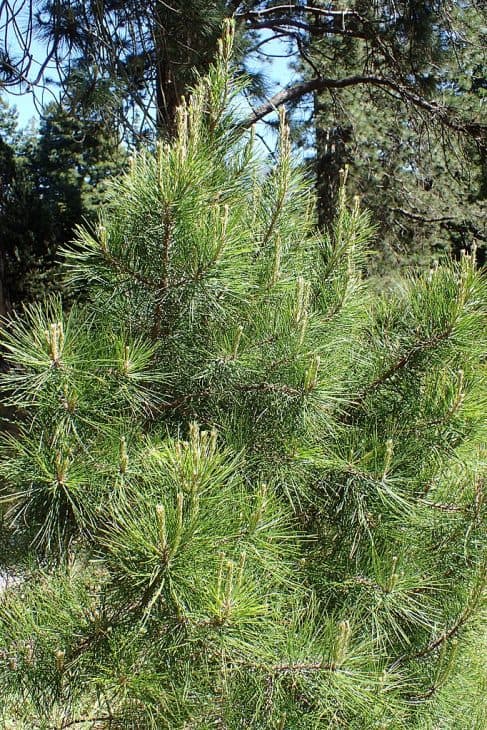
Also called the yellow pine, this tree is native to the eastern part of the country and is used mostly for veneer, lumber, and wood pulp. Its needle-like leaves grow in groups of two or three mixed together and it can be either crooked or straight in shape.
38. Singleleaf Pinyon Pine (pinus monophylla)
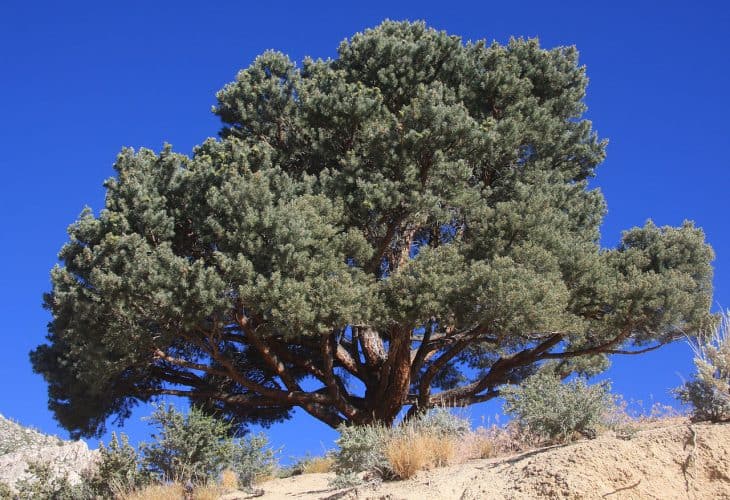
Native to North America, the singleleaf pinyon pine tree grows best in moderate altitudes and is considered a medium-sized tree because it only gets to around 30 to 60 feet in height. There are three subspecies of the tree. It is used as a decorative tree and a Christmas tree in some areas.
39. Slash Pine (pinus elliottii)
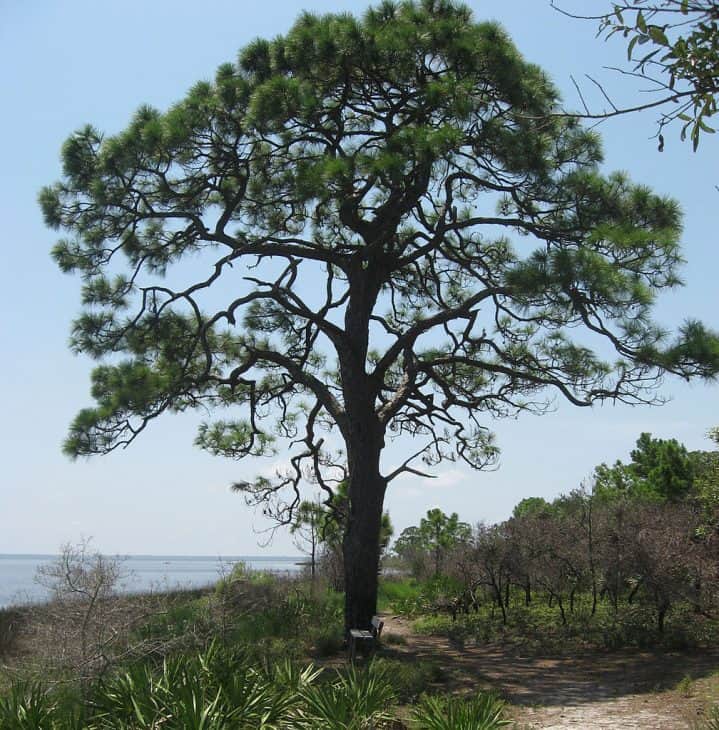
The slash pine tree grows from 60 to nearly 100 feet high and tends to live a shorter period of time than other pines, usually around 200 years. It is similar to the loblolly pine but has longer, glossier needles and it consists of two different varieties.
40. Southern Foxtail Pine (pinus balfouriana austrina)
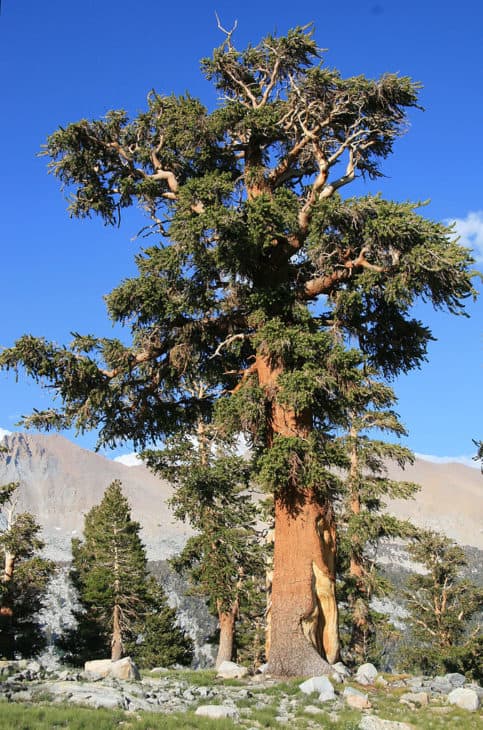
Growing up to 30 to 70 feet in height, the southern foxtail pine tree has a large trunk that can get up to seven feet in diameter. Its needles grow in bundles of four or five and the cones are two to four inches long. The tree can live from 1000 to 3000 years.
41. Spruce Pine (pinus glabra)
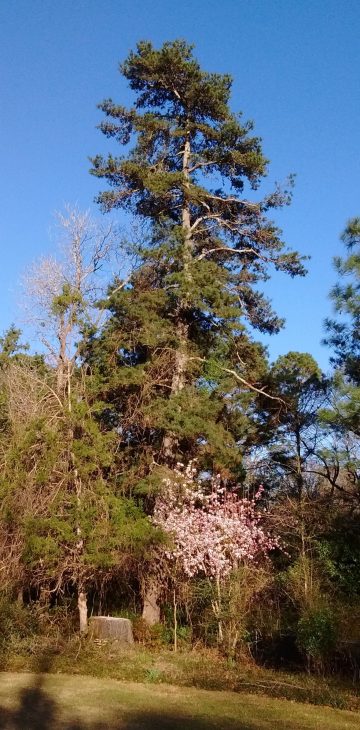
Mostly found along the southern and eastern coasts, the tree can get up to 130 feet high and has needles that grow in groups of two. The needles are glossy and dark green in color; the cones are small and slender with few prickles on them.
42. Stone Pine (pinus pinea)
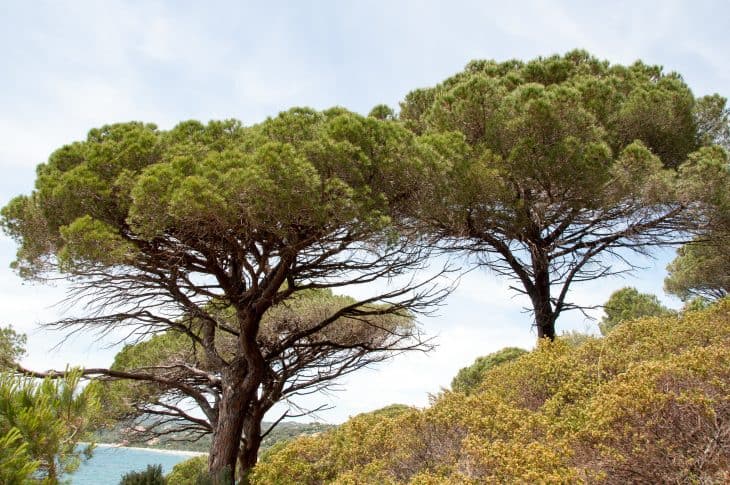
Also called the Italian stone pine tree, it has been cultivated for its pine nuts since prehistoric times. It grows from 40 to 65 feet in height and its many uses include as a food source, for ornamental and decorative uses, and even for its resin.
43. Sugar Pine (pinus lambertiana)
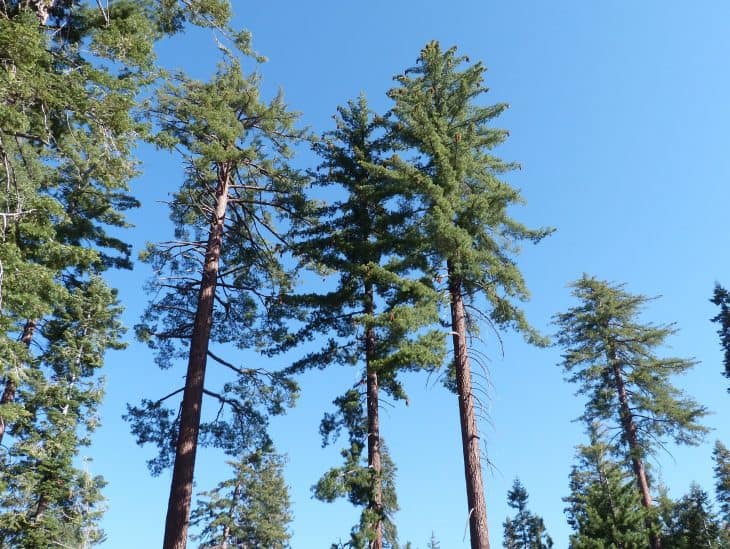
The sugar pine tree is one of the most massive pine trees in existence, getting up to roughly 200 feet in height and having a trunk diameter that can get up to eight feet. Found mostly in the western part of the country, the sugar pine has odorless wood that is often used to store fruit and pack drugs.
44. Table Mountain Pine (pinus pungens)
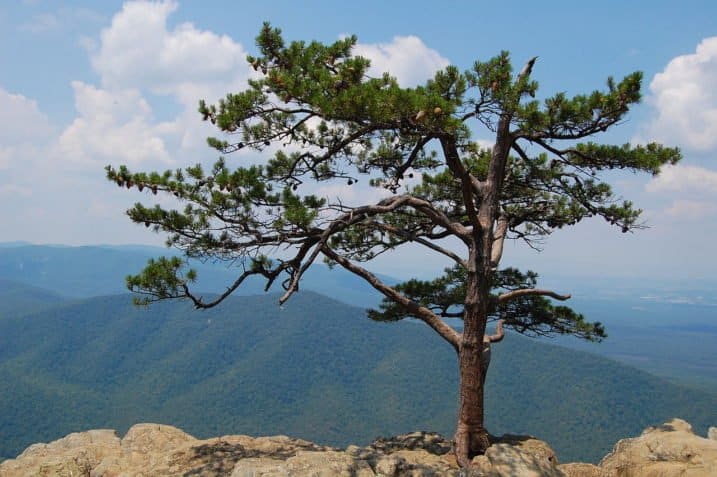
The table mountain pine has a round but irregular shape and is considered a medium-sized pine tree. Sapling trees are usually able to produce cones in as little as five years. The tree prefers rocky slopes and higher elevations.
45. Torrey Pine (pinus torreyana)
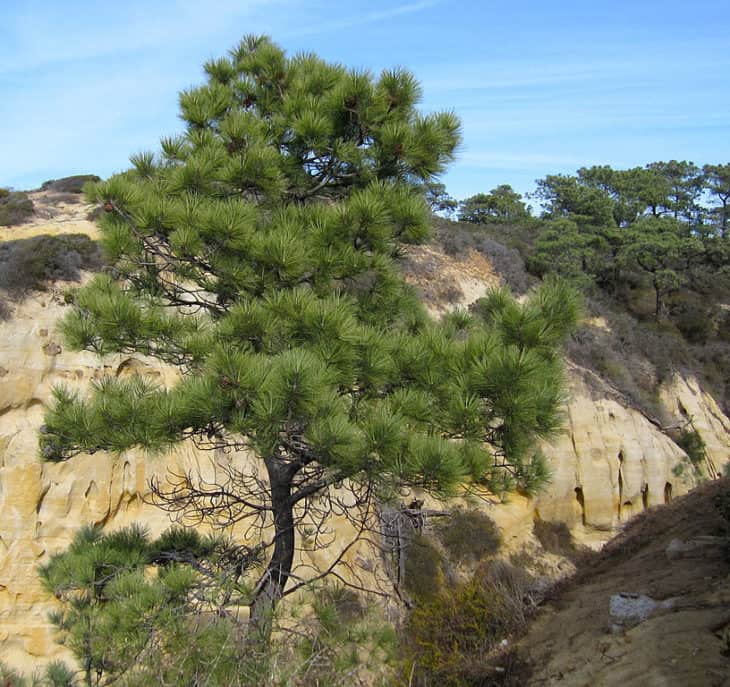
The torrey pine tree is a rare type of pine that is usually 25 to 50 feet in height. The cones are large and heavy and the pine nuts are large but edible and tasty. The tree is used as an ornamental tree, in plantation forestry, and, of course, as a food source.
46. Two Needle Pinon Pine (pinus edulis)
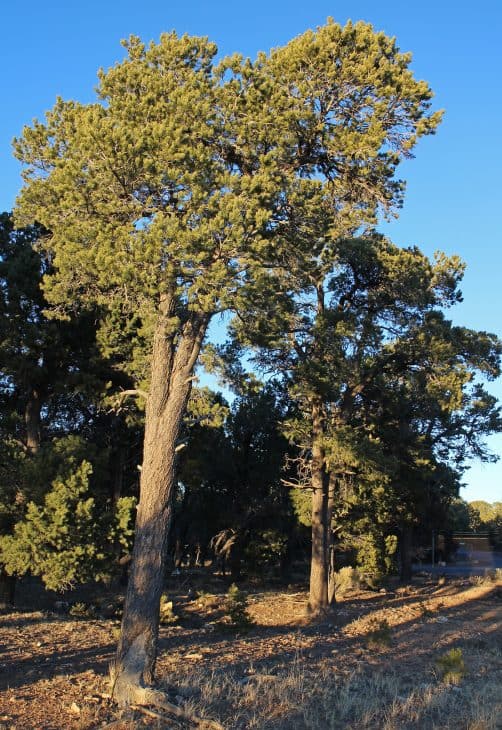
Also called the Colorado or nut pine tree, the two needle pinon pine tree grows 30 to 65 feet high and has a diameter of roughly 30 inches. It is cultivated mostly for its pine nuts as well as an ornamental tree, as a decorative tree, and occasionally as a Christmas tree.
47. Virginia Pine (pinus virginiana)
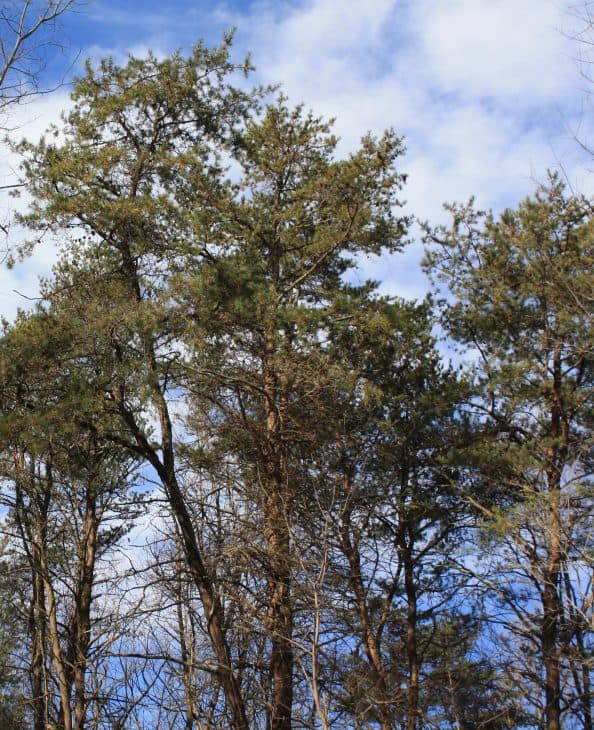
Also called the Jersey or scrub pine, the Virginia pine tree is found throughout the eastern parts of the country. It is used frequently for reforestation as well as for wood pulp and even lumber. It is known for its very short needles that are twisted and grow in bundles of two.
48. Washoe Pine (pinus washoensis)
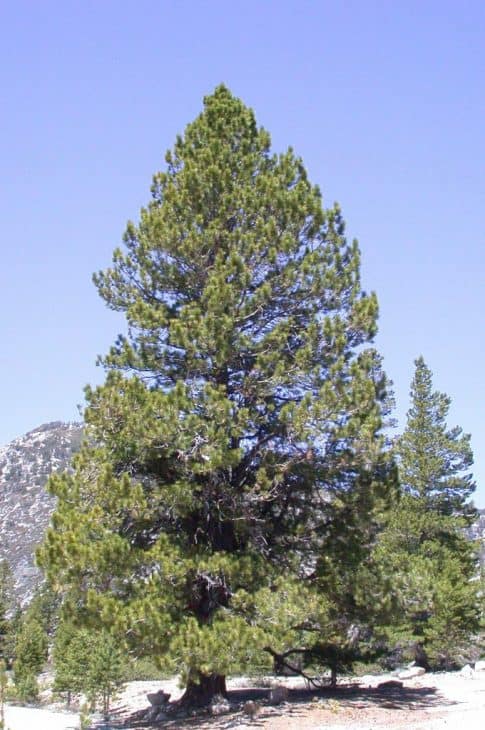
The washoe pine is mostly known for its ornamental and decorative use and is typically found in public parks and gardens. It can get up to 230 feet in height and has five separate subspecies. Some claim that the bark has a very distinct smell.
49. Western White Pine (pinus monticola)
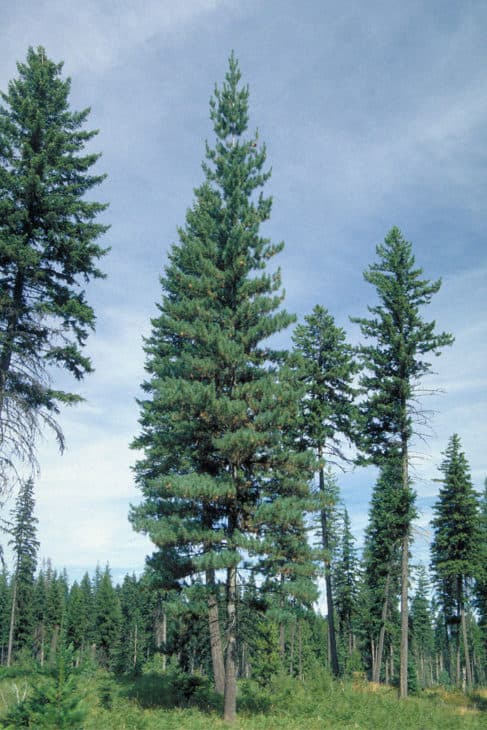
Also called the silver pine, this tree grows 100 to 160 feet high and has large cones and leaves that last a very long time. In many areas, the tree can be found growing down to sea level. Since it is found frequently in the western part of the country, it is often called the Idaho pine.
50. White Pine (pinus strobus)
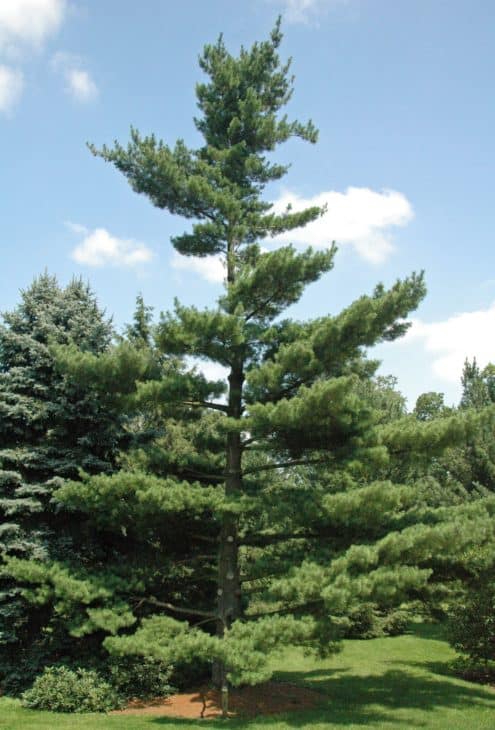
Also known as the Weymouth pine, the white pine gets up to nearly 190 feet in height and can have a diameter of more than five feet. It is mostly used as lumber and in some medicines, especially by Native Americans.
51. Whitebark Pine (pinus albicaulis)
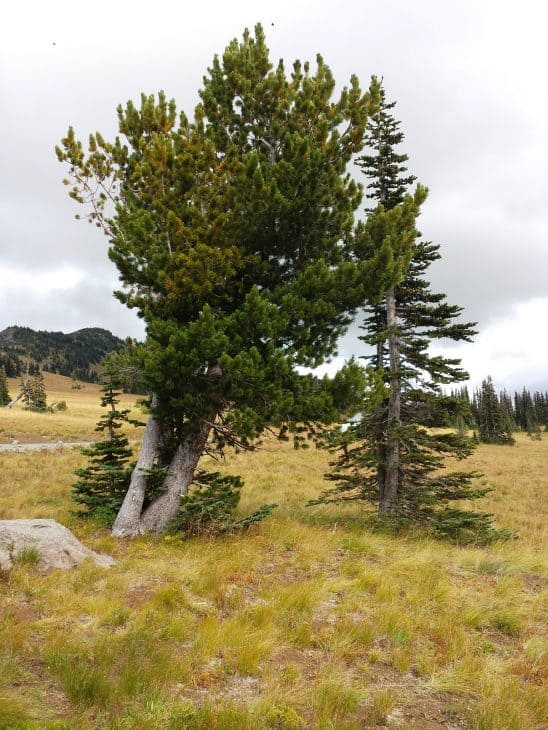
Also called the creeping pine, the tree is part of the white pine group and has been used in the past by Native Americans as a food source because they ate the nuts of the cones. The needles grow in groups of five and the cones are usually two to four inches in length.

